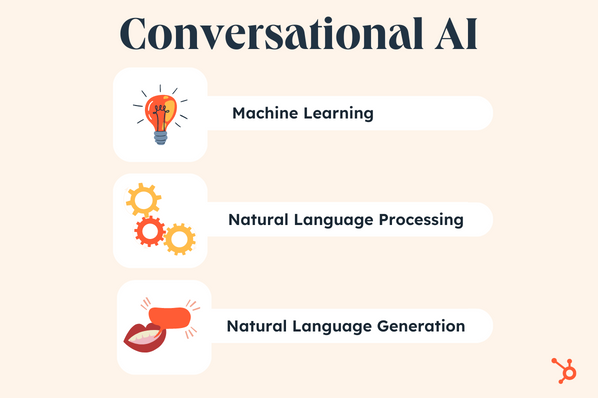As industries prepare to make changes to marketing personnel in the coming months, marketing department restructures are on the horizon. If you’re facing the pressure to grow revenue through marketing while keeping headcount to a minimum, you’re in luck.
We’ve cracked the code on how to structure a high-performing marketing team, and now, I’m going to share those insights with you.
In this post, I’ll walk you through what a marketing team structure looks like for small, midsized, and enterprise businesses, which structure will work best for you, and how to make your first or next marketing hire.
Marketing Team Sizes
First, let’s define what we mean by different company sizes. You may not agree with all of them, and that’s OK; we’re only using these numbers to establish a common lexicon in this guide.
- Small to Medium Sized Business (SMB): 5-100 Employees
- Midsized Business: 101-1,000 Employees
- Enterprise: 1,000+ employees (not including the massive Fortune 500 orgs)
Now that we’ve agreed on sizes, let’s talk about the marketing department structures you have to choose from.
How to Structure a Marketing Department
Here, I’m outlining three types of marketing department structures. These are dependent upon how large and how predictable your business is. Midsize companies with less predictable revenue forecasts may find a team structured by specific marketing disciplines will work better for them, while enterprise organizations with more predictable revenue forecasts can use a structure that has more opportunity for experimentation.
1. Marketing Department Structure by Discipline
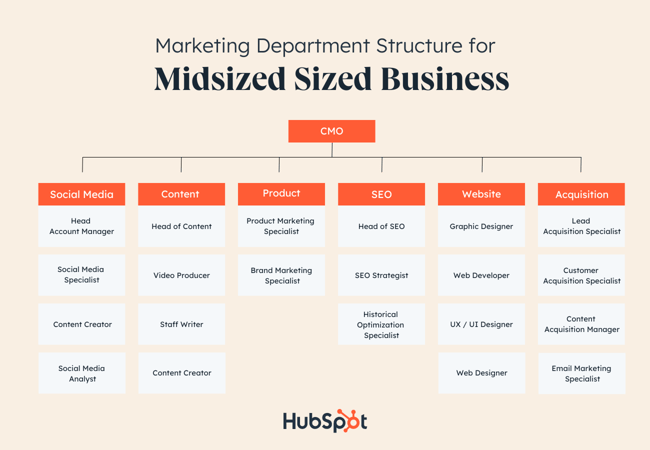
Marketing departments that are structured by discipline are the most common. You’ll see these structures in midsized companies where marketing owns a revenue number and is responsible for driving leads and contributing to the pipeline of the business. These teams will collaborate to execute campaigns frequently throughout the year in order to hit the company’s revenue goals.
Here are some of the most common teams within the marketing department that are structured by discipline:
Social Media
Skills needed: Content creation, graphic design, social media management, project management, data analytics, and storytelling
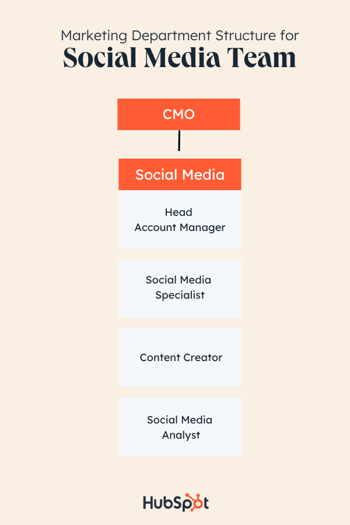
Your social media team will create and execute social media marketing efforts. This team will need to have knowledge of how to make engaging content to drive brand awareness, generate leads, and connect with audiences.
To properly perform these job functions, your social media team should have a working knowledge of creating, scheduling, and measuring the performance of social content.
Basic graphic design skills or knowledge of design tools like Canva or Adobe will be necessary for the content creation side, while social media management tools will help teams track performance, measure success, and schedule content.
Teams also need to be comfortable with customer service, as social media teams will be the ones responding to customers who engage through social media tags or posts. They will also be communicating to customers through content copy, blog posts, and comment sections, so an understanding of the company voice and ideal customer is key.
To help small teams, social media management software provides marketers with the tools they need to execute an entire social media strategy, such as the tools within HubSpot’s Marketing Hub.
Social media structure by team size:
SMBs with a team member dedicated to marketing should have a general comfortability with basic marketing practices and social media experience to build an online presence. If you can afford multiple marketing roles, start specializing in marketing functions like social media manager, which can be its own role.
Enterprise teams can structure their social media team by having specialists and managers to lead and oversee social media strategy, as well as roles for day-to-day social media activities, such as creating Instagram Stories and Posts, video editing for Facebook, and content management.
Potential roles:
- Head Account Manager
- Social Media Specialist
- Content Creator
- Social Media Analyst
Content Marketing
Skills needed: Writing, editing, organization, graphic design, project management, SEO, HTML, and storytelling
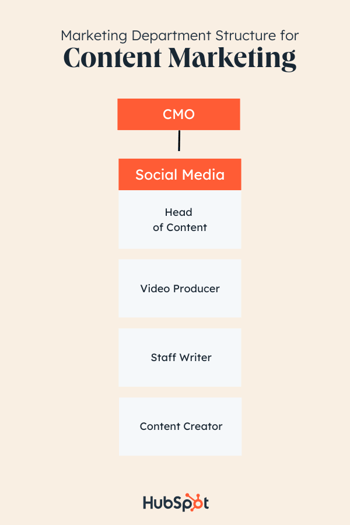
Your content creators will be the ones making sure your brand has enough content to tell a cohesive, compelling story. The content they produce will be useful in every facet of your marketing functions, from video to blog posts.
Content creators are skilled writers; they usually know how to create a solid blog post or webinar. They also have to be keen on editing — their blogs, videos, and social media content depend on it.
This team will be the go-to for the production of high-quality multimedia assets for your business, including podcasts, videos, ebooks, or other materials as needed. They may have to work on projects with other teams to make sure the messaging is correct, so your content creators should be ready to collaborate with others.
When building this team, make sure that your content creators are familiar with online management software, like HubSpot’s Marketing Hub. This makes their job easier. Instead of having to analyze data from multiple different sources, online software keeps all of that data in one place.
Content structure by team size:
In a startup, your content creation team might also be your social media and product marketing team. Though the roles are similar, content marketers need to have good organization and time-management skills in a fast-paced environment, so make sure the person you hire can work autonomously and in a team setting.
Hire a content creator who understands the story of your brand and brand voice. Their methods of sharing your voice through video, podcast, or ebooks should ultimately incentivize prospects to learn more about your business.
Larger companies hiring for a content creation team can hire by skill or by the needs of other teams. For example, Social Media Agencies need content creators for every client or group of clients.
Potential roles:
-
Head of Content
-
Video Producer
-
Staff Writer
-
Content Creator
-
Jr. Content Creator
Product
Skills needed: Research, analysis, strategic planning, cross-functionality, writing, customer service, a creative problem-solving mindset, technical knowledge, pricing strategy, and solving for the customer

This team is so important because they will communicate the features and benefits of your product to the customer. They’ll organize and drive the messages of a product and how it connects to your brand and the customer.
Product marketers identify target audiences to communicate with through product pages and ad copy. In addition, product marketers need to be star planners with keen attention to detail, as they will be planning campaigns for your products or services.
When you hire a product marketer, look for someone who demonstrates a deep understanding of overall marketing functions since, for start-ups, they might be your only marketer. They need to know how to research, analyze metrics, use that knowledge to plan future campaigns and target the customer’s needs in all of your business’s marketing materials.
In order to bring a product to life, a product marketer needs to know how to build an effective product page, and include content that will highlight that. They need to be able to present their strategies to other decision-makers and have plans for every strategy.
Product structure by team size:
The product marketer you hire as a small business owner is likely your only marketer, or the one leading marketing efforts with another team member. Hire someone with a background or demonstrated knowledge in writing, presenting marketing, and business.
Remember, the product marketer will communicate the product’s usefulness to customers, so the team member’s skills should be robust. If you are hiring for a larger team, then, you can have a little more flexibility. You can hire product marketers by product stack, so for instance, phones and personal laptops could be product stacks for a tech company.
You can structure your product marketing team by specialty, as well—a role based solely on developing copy or producing strategy, for example.
Potential roles:
- Brand Specialist
- Product Marketing Specialist
Search Engine Optimization
Skills needed: Writing, editing, problem-solving, experience with programming and technical thinking, analytics, spreadsheets, drive, and the ability to adapt

The SEO team will mainly be driving traffic to your webpages by optimizing content and ensuring your brand is aware of the keywords necessary to rank on the SERPs for topics related to your product or service. Occasionally, they’re also required to lend expertise to make business decisions. To accomplish these goals, SEO teams need to be made up of individuals with strong technical, programming, and writing skills.
Some SEO functions require writing, editing, and proofreading content to optimize it for audiences. This is where having a strong writing background will come in handy. SEO teams should be excellent problem-solvers and think about how to optimize content specifically for search engines.
These hires should be comfortable finding and implementing keywords, which will improve how high your business ranks on Google. They will also have to develop strategies for link building and develop a basic SEO protocol for the company.
In addition, SEO specialists should be fluent in analytics software to ensure they’re able to incorporate the lessons from those metrics into their overall strategy.
SEO structure by team size:
If you work for a small company, your SEO strategist might be melded with another role. If that’s the case, make sure that the SEO functions are being carried out by someone who has an understanding of analytics and optimizing content for search engines, as well as conducting thorough keyword research..
In other words, if they can’t speak Google or Bing’s language, they probably aren’t the right fit.
Comprehending analytics and optimizing content for SEO purposes will help your business rank on search engines and reach new prospects, or nurture leads until they’re ready to purchase..
For businesses that are large enough to build a team, hire for different specialties within SEO. For instance, you can hire for historical optimization, link-building management, or raising webpage traffic.
From there, you can hire project managers and team managers who are experts in the field of SEO and can offer seasoned advice to other team members, as well as manage multiple SEO projects at once.
Potential roles:
- SEO Strategist
- Senior SEO Strategist
- Historical Optimization Writer
Website
Skills needed: Programming, Creative Suite programs, interpersonal communication, Website and email design, user-experience orientation, content management software, understanding of web standards and best practices, and SEO

Of course, any business needs a website. And as your company grows, you may find the need to hire someone full-time to maintain your website. This team will be responsible for all things dot com, so you should hire a creative proficient in web design, web strategy, and optimization.
Your web design team will use their mastery of programming and web design tools to create and maintain the message your website is conveying. They will work closely with product marketing and content teams on web page execution, so the ability to collaborate across teams is essential.
They will be the point of contact for someone who runs into a problem on your website and should be able to fix any technical issues that may arise. You should trust your web design team to create a user experience that keeps customers coming back.
Website structure by team size:
The general function of a web designer is to make the web page experience seamless, optimized, and engaging for every visitor. They’ll use their expertise to deliver a delightful experience to customers who interact with your business’s web pages.
You can structure your web design by need, but if you can afford to build out an entire team, you can start hiring Senior Web Developers to bring your site up to current standards and maintain it, while Associate level hires can assist with those job duties as your design team grows.
Potential roles:
- Web Developer
- Senior Web Developer
- UX / UI Designer
- Front-end Web Developer
- Web Designer
- Visual UX Developer
- Graphic Design Specialist
Acquisition
Skills needed: Customer centricity, written and verbal communication, solution-driven mindset, and attention to detail
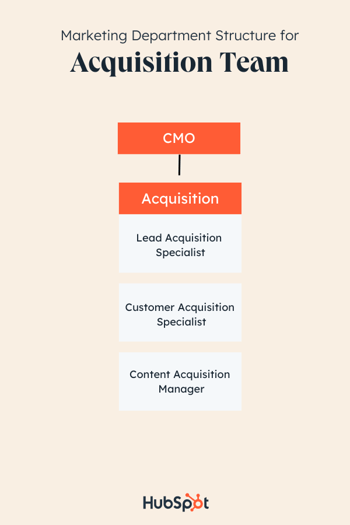
Though the entire marketing team should be customer-obsessed, your Acquisition team will be made up of those who live and breathe methods for delighting the customer through every step of their buyer’s journey.
Acquisition hires are the first contact with customers — they will introduce audiences to your brand. Your acquisition team will communicate to the customer as a representative and advocate for the company, and need excellent customer-facing skills and company knowledge to do so.
Another skill valued in an acquisition team is attention to detail; these teams have to be experts in how products can help customers and capitalize on little moments that can enhance the customer experience.
The biggest question for an Acquisition team to answer is, “How can we delight the customer for every stage of the buyer’s journey?” and projects should reflect that. For instance, creating compelling content offers and tracking the performance of these CTAs will be essential for teams to make impactful strategies for driving growth.
Acquisition structure by team size:
For companies whose members don’t have the resources to build a full Acquisition team, make sure the team member you designate for acquisition can effectively communicate your brand. They should know how to delight customers every step of the way.
If you’re building a team for a larger company, hire for an Acquisition team with roles that are either exclusively customer-facing or exclusively non-customer-facing. Individual hires will be able to focus their job functions based on their interaction with customers.
For example, someone in a non-customer-facing acquisition role could have duties such as developing CTAs and content offers, so writing experience and an understanding of basic graphic design practices are critical. Customer-facing roles, then, will onboard customers, source and contact them, and identify and ease pain points they might have in their journey.
Potential roles:
- Lead Acquisition Specialist
- Customer Acquisition Specialist
- Content Acquisition Manager
2. Marketing Department Structure by Function
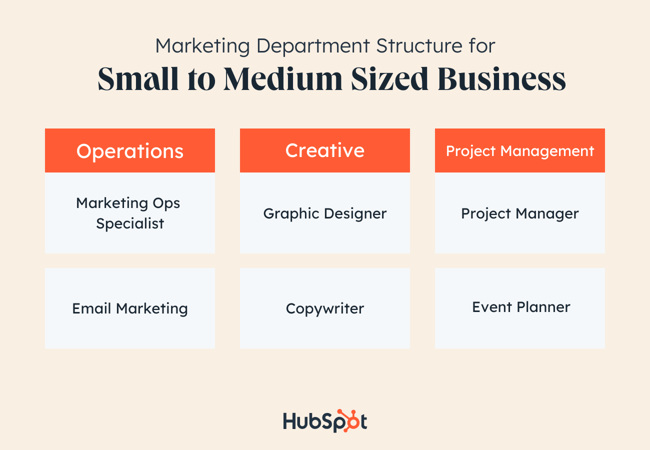
A slightly more traditional organization structure than the product structure above, the functional department structure leans heavily on the nuts and bolts of what makes great marketing work. This structure is similar to that of a bare-bones agency. It includes the pillars of taking a campaign from ideation to completion.
The functional marketing department structure works well for small teams that have limited headcount, resources, budget, and bandwidth. A team like this may be made up of a few full-time folks, part-time people, or it could be staffed completely by contractors.
For this structure, it’s common that your marketing department won’t own a revenue number and attribution won’t be too important (non-profits, very small service-based companies). If you’re a marketer who wears many hats and needs to hire folks with a similar work ethic, try this structure.
Operations
Skills needed: workflows, automation, written and verbal communication skills, problem-solving, team-building
Your operations team is responsible for managing the technical aspects of your marketing efforts. They’ll maintain the tech stack, handle marketing automation, manage email marketing workflows, and schedule and produce webinars.
Potential roles:
- Marketing Ops Specialist
- Email Marketer
Creative
Skills needed: graphic design, written communication, video production, photography, copywriting, front-end web design
The creative team is in charge of what your clients or customers see when they come across your brand. This team will take on graphic design, copywriting, video production, and some web design.
Potential roles:
- Graphic design
- Copywriter
Project Management
Skills needed: organization, project management, agile framework, budgeting, time management, written and verbal communication
To keep everything on schedule, within budget, and within scope, the project management team will step in. The individuals in this role will typically coordinate with both operations and creativity in order to keep things moving. They’ll manage vendors, contractors, and freelancers and also work as an event planner if needed.
Potential roles:
- Project manager
- Event planner
- Vendor manager
- Procurement specialist
3. Marketing Department Structure by Product

This marketing department structure organizes marketing teams by product. You might be thinking, “But marketing doesn’t own a product?” and that is true in the literal sense of the term, but when you think of marketing as a figurative product, you can better organize people around that product’s goals.
This approach works well for enterprise teams with predictable revenue patterns that don’t need to run frequent, stand-alone marketing campaigns to generate business. If there’s a proven marketing system in place to generate demand for the business, you can leverage a product-style marketing structure to grow in new, innovative ways. Global teams may also appreciate this structure because it reduces role redundancy across regions and gives hiring managers an opportunity to recruit talent globally.
There are three typical “products” within this type of marketing structure, plus one emerging “product” that can help differentiate your business if it makes sense within your industry.
Brand Team
Skills needed: strategic thinking, written and verbal communication, creativity, copywriting, social media management, customer journey mapping, and buyer journey mapping
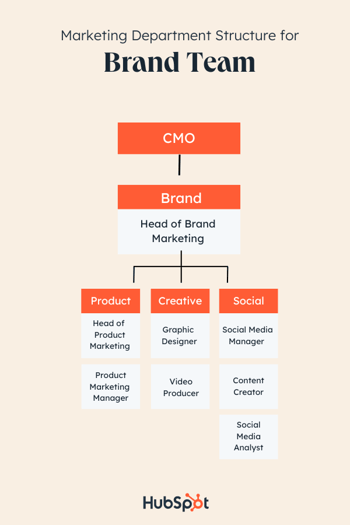
Brand includes everything about your business and distills it in such a way that potential, new, and existing customers can relate to it and external entities can appreciate it. When you’re thinking about building your marketing team around brand as a product, consider these ideas:
- Who would be responsible for the brand strategy?
- Who would be responsible for the way the brand looks, sounds, reacts, and shares ideas?
- Who would be responsible for influencing the brand in other parts of the business?
- Who would be responsible for the day-to-day championing of the brand?
Growth Team
Skills needed: Content marketing, content strategy, SEO, copywriting, web design, UI/UX design, and HTML
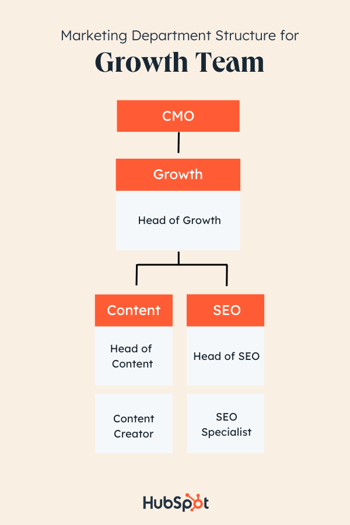
Growth marketing is responsible for generating demand and leads for the business either in existing or new markets. When you’re thinking about building your marketing team around growth as a product, consider these ideas:
- Who determines how much we grow, how fast we grow, and in which markets we grow?
- In which channels do growth opportunities exist?
- What is the short and long-term payoff of the growth strategy?
Acquisition Team
Skills needed: conversion rate optimization, UI / UX design, HTML, content development, content design, and data analysis
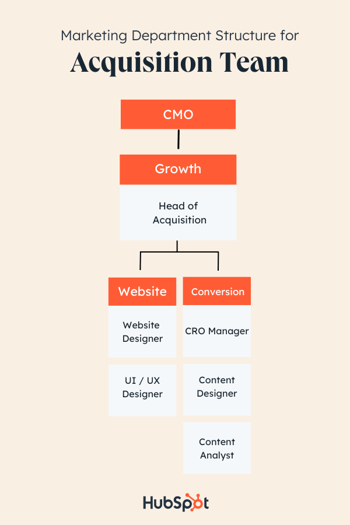
Once you’ve drawn the audience in and you’ve set growth goals, you’ll look to your acquisition “product” to secure leads and fill the pipeline for sales. When you’re thinking about building your marketing team around acquisition as a product, consider these ideas:
- Who would be responsible for the acquisition strategy?
- Who will be responsible for lead scoring and lead nurturing?
- How will the team attribute success?
Media Team
Skills needed: Video production, video editing, public speaking, creative writing, research, data analysis, and journalism
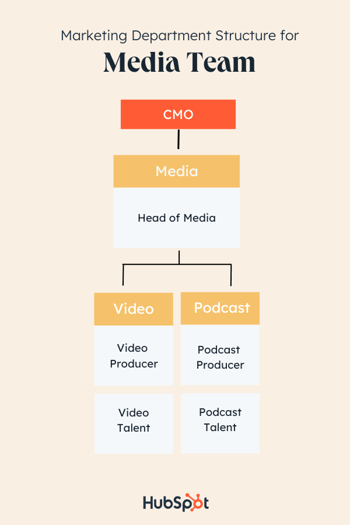
This emerging marketing “product” can and should encompass each of the three mentioned above, but it does so with an emphasis on the audience experience. Media products are best built when your brand product has a strong foothold in the market. When you’re thinking about building your marketing team around media as a product, consider these ideas:
- Is my company’s brand well-respected and sought after for thought leadership, publishing opportunities with highly-respected institutions, and generally regarded for setting the industry standard?
- Are both customers and non-customers engaging with existing marketing content from my company?
- Do the decision-makers within my industry consume media regularly enough to make this “product” worthwhile?
Types of Marketing Team Roles & Positions
Any successful marketing department structure needs a leadership and individual contributor hierarchy. How deep or wide you choose to organize your team is up to you, but here are the primary roles (in total or in part) you can expect to see in any marketing team.
Use this list to ascertain which roles you already have on your team, who in your company you can prepare for these roles, and who you should hire next.
Marketing People Leader Roles
1. Chief Marketing Officer (CMO)
Decision-making, owning the vision, and championing the team culture is the job of the CMO. This role sets the tone and standard for the entire marketing team and makes the call when the structure needs to change. The CMO reports to the CEO of the company with regard to how marketing is contributing to the business’s bottom line.
2. Vice President of Marketing
Setting the strategy for the marketing department at a high level is the responsibility of the VP. VPs may have ownership of specific products, functions, or disciplines which shapes the details of what this role looks like. They’ll have directors as direct reports and will interface regularly with skip-level reports.
3. Director of Marketing
You may see this role called a “Head of” instead of a director. The director of marketing is closely tied to their specific team which could be the entire marketing department at smaller companies or a subteam, like social media, for larger orgs. Their duties consist of putting the strategy from the VP into an actionable plan that managers can rally their teams around.
4. Marketing Manager
Marketing managers are people leaders on the front lines who manage individual contributors. Their day-to-day consists of weekly check-ins with direct reports and the director of marketing. They’re responsible for guiding their team toward meeting the goals and KPIs of the strategy.
Marketing Individual Contributor Roles
1. Marketing Consultant
A marketing consultant is typically an expert in a specific discipline like SEO or content creation. They are hired as a freelancer, contractor, or even on a part-time basis to help marketing teams reach their goals. Marketing consultants are critical to the mission of the team, but their expertise is needed in a limited capacity. If you don’t need a full-time hire on your marketing team, but would like to explore new channels, strategies, and tactics, consider bringing on a marketing consultant.
2. Principal Marketer
This individual contributor role is one of the highest-level full-time roles an individual contributor can attain in their career. These individuals are masters of their discipline rather than a jack of all trades. Internal and external team members look to them for guidance and industry-standard best practices. They may have more than a decade of experience in their discipline, but oftentimes, they have even more experience in other areas of marketing under their belt.
3. Senior Marketer
A senior marketer is one step below the principal marketer. They’re honing their skills in a specific discipline, but they may take on projects with a wider scope to build other soft and hard skills. They’re savvy with the latest trends in the marketing space and can serve as a mentor to junior members of the team.
4. Marketing Specialist
A marketing specialist plays more of a generalist role on the team. If the principal marketer is a master of one, the marketing specialist is a jack of all trades. They’re encouraged to explore a wide variety of marketing disciplines to gain an understanding of how tactics work together to achieve the strategy. From there, they’ll develop their skill set in one area of marketing that they’ll use to guide the rest of their careers.
5. Marketing Coordinator/ Marketing Associate
A marketing associate is an entry level position for recent graduates or new marketing professionals who want to change careers. They’ll take on ad-hoc assignments in various marketing departments and begin to build relationships with more senior team members. They may have an interest in one area of marketing, but they’ll work on several projects to become familiar with marketing as a whole.
6. Marketing Intern
The marketing intern is a temporary employee that is completing a degree of some kind, usually in an area of marketing or communications. They’ll explore various disciplines during their time in the company and learn how to apply the marketing lessons they learn in class to real-world situations. They may be offered a full-time position as a marketing associate or coordinator upon graduation.
How to Build a Marketing Team
1. Create a hiring strategy.
Before you can hire anyone, you need to put a strategy in place for building your marketing team.
You’ll need a clear understanding of your organization’s hierarchy. Consider how the roles within these teams overlap. For example, think about how the Acquisition and Content teams will work together.
2. Write the job descriptions.
After that, you can start to write the job descriptions and begin recruiting.
You can post jobs on your website, or on job boards like Indeed. When the applications begin rolling in, you can start to interview and vet your candidates.
It’s important that the people you hire mesh well with your team, so don’t hesitate to ask marketing friends for referrals.
Additionally, pay attention to LinkedIn connections while you’re vetting potential candidates in case you have a mutual connection. Leadership skills and the ability to fit in with your company’s culture are key here.
Plus, keep in mind that you want to hire experts. Your team should have experience and know what they’re doing.
3. Source candidates.
Before you begin recruiting candidates from external sources, look to your current team to see if anyone is interested in a marketing career. Not only does an internal candidate give you an opportunity to help someone progress their career, it saves you time and resources that you’d otherwise spend looking for external talent and getting them up to speed on your business.
If you’ve exhausted your internal talent pool or you need a more specialized skill set, there are several resources available to make this happen. Look to recruiters, headhunters, and candidate sources to help with the search. You can also browse candidate collectives or private membership groups like Black Marketers Association of America to list your job posting.
4. Extend an offer.
There’s a lot of discourse about how to interview for top marketing talent. How many interviews are too many? How do you know which candidate is the right fit? How long should the process take? We know that can be a challenge for small and large companies alike, so use this free resource to understand what you need to ask to evaluate your candidates objectively.
Once you’re ready to extend an offer, consider all the variables: their experience, their interview performance, their formal marketing training (courses, degrees, certifications), and any special skills that will help round out your team.
Use this information to craft a fair offer that aligns what they bring to the table with what the market demands. Be prepared for negotiations and questions about commonly overlooked benefits like insurance, on-call responsibilities, and professional development allowances.
5. Onboard the team.
After you’ve hired your team, you aren’t done building a great team. Building a great team continues long after the hiring process. For example, your onboarding process should help your employees understand the team culture.
Over time, building a great team is about documenting your goals, identifying gaps, and iterating on your process.
Build Your Marketing Dream Team
Hiring the best talent will require knowing the best skills for each role. Even if you’re hiring for a startup or small business and only have resources for 1-2 marketing roles at the moment, it’s still helpful to know the most transferable skills that will help you hire people who can grow into new roles in the future.
When you start with the right structure for your business type, put the right steps in place for hiring, and get the team aligned on a common vision, you’ll have a marketing team that will make even some fortune 100 companies envious.
Editor’s note: This post was originally published in November 2014 and has been updated for comprehensiveness.
![]()

![→ Click here to download our free guide to hiring and training a team of all-stars [Free Ebook].](https://i4lead.com/wp-content/uploads/2023/03/c42148d7-13dd-4c38-b907-cff1602ee62f.png)

![Download Now: The 2023 State of Social Media Trends [Free Report]](https://i4lead.com/wp-content/uploads/2023/03/3dc1dfd9-2cb4-4498-8c57-19dbb5671820-3.png)

![→ Download Now: Free Product Marketing Kit [Free Templates]](https://i4lead.com/wp-content/uploads/2023/03/08b5e1f4-5d26-405b-b986-29c99bd0cb14.png)
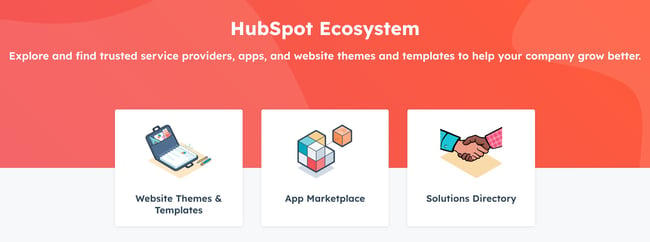
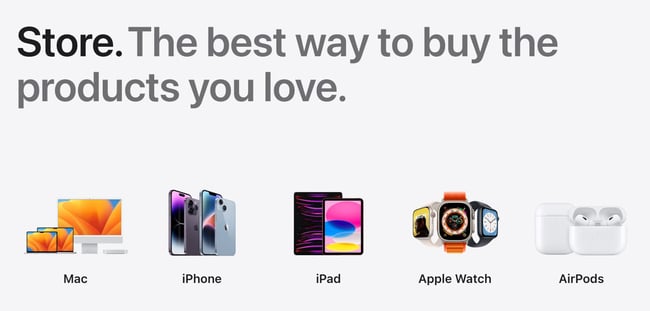

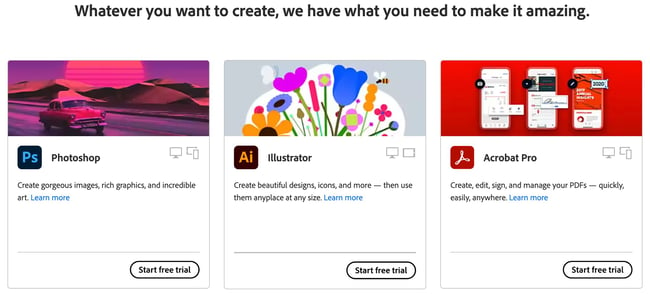
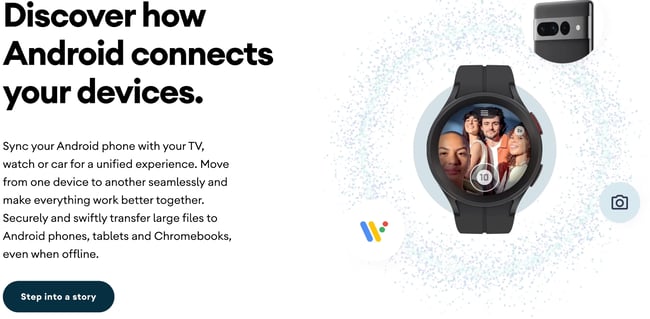
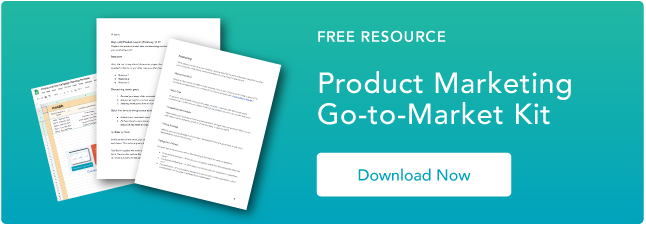
![Download Now: 150+ Content Creation Templates [Free Kit]](https://i4lead.com/wp-content/uploads/2023/03/5478fa12-4cc3-4140-ba96-bc103eeb873e.png)





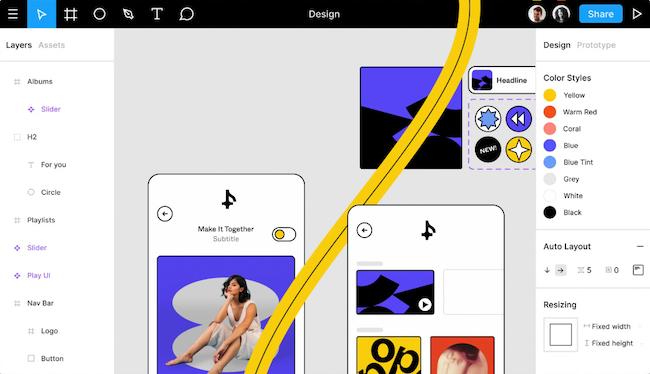




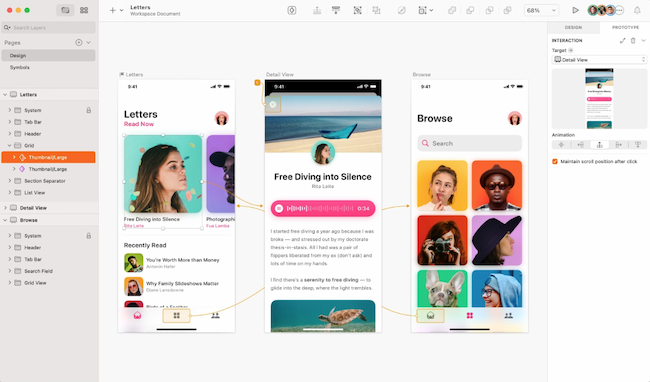


![→ Download Now: SEO Starter Pack [Free Kit]](https://i4lead.com/wp-content/uploads/2023/03/1d7211ac-7b1b-4405-b940-54b8acedb26e.png)

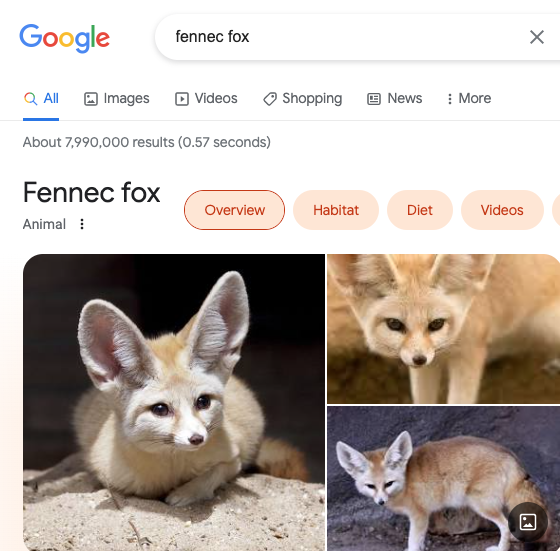
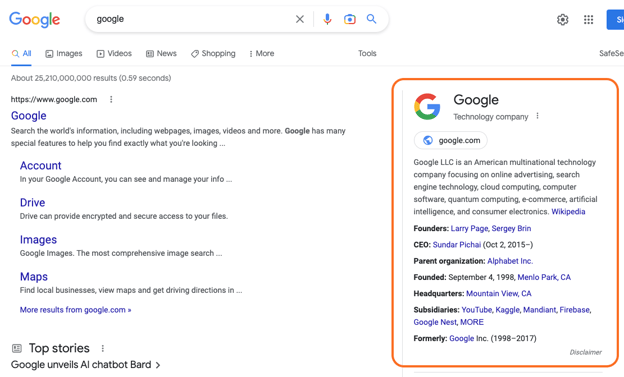
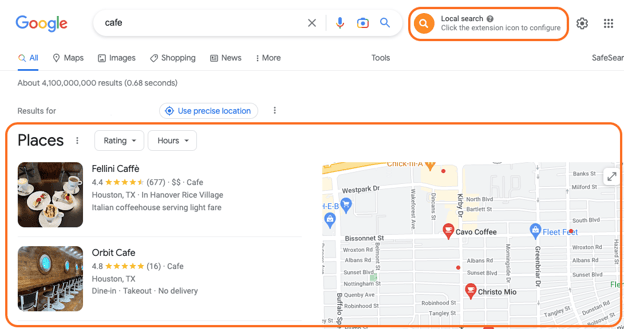


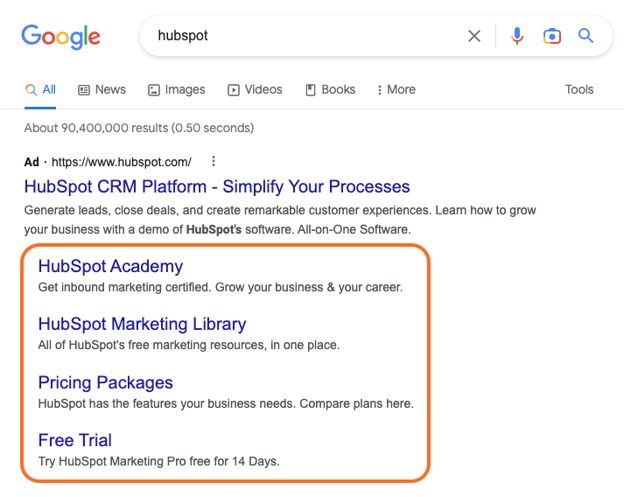
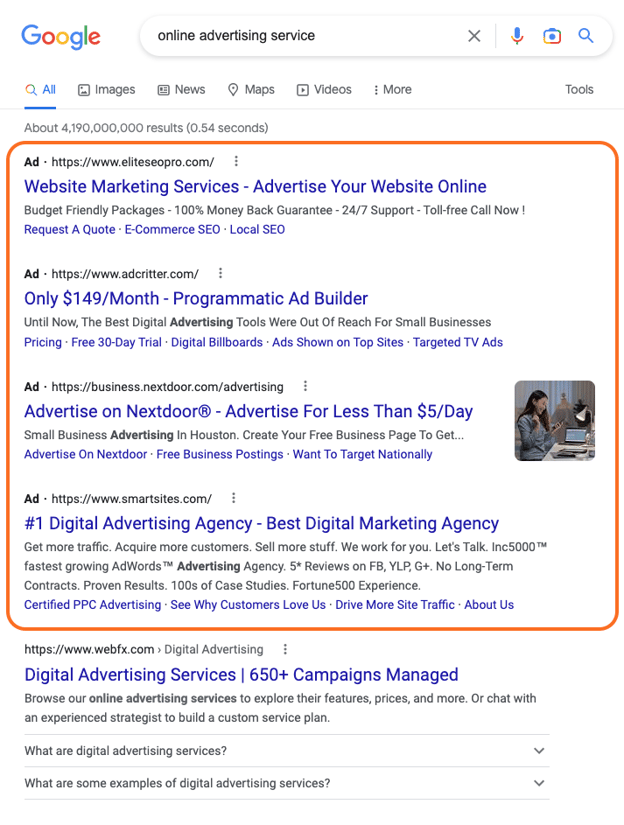
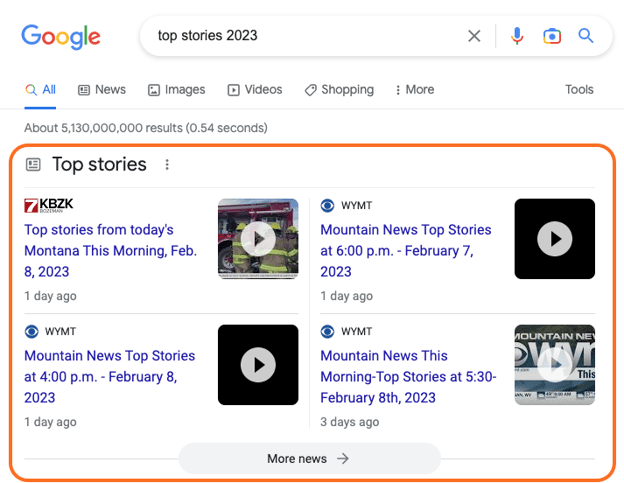




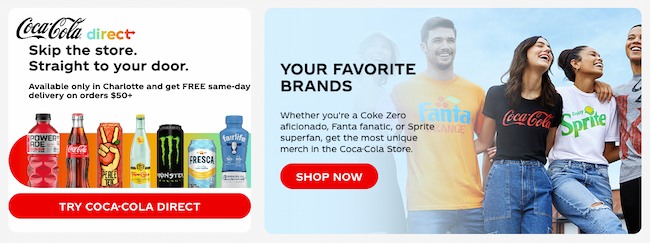
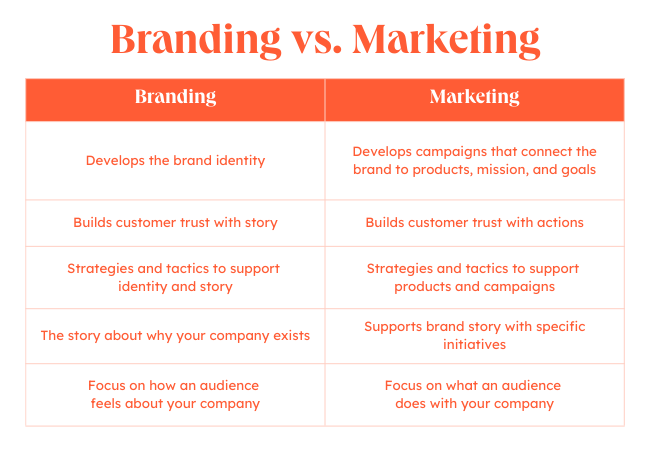
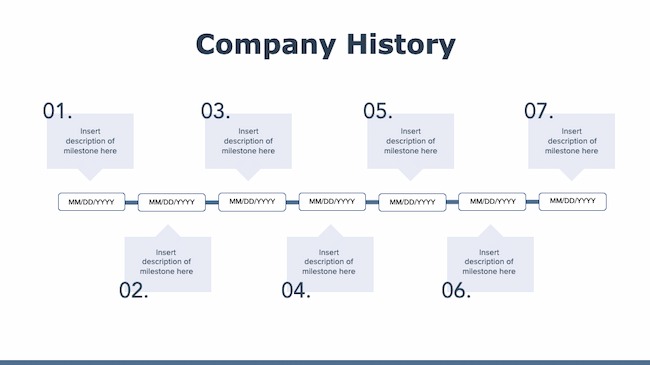




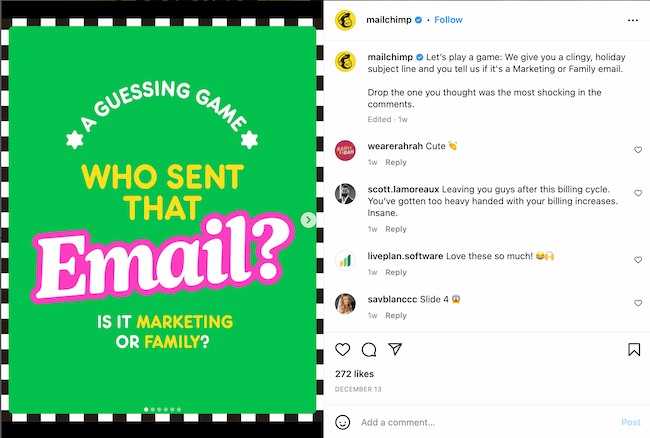
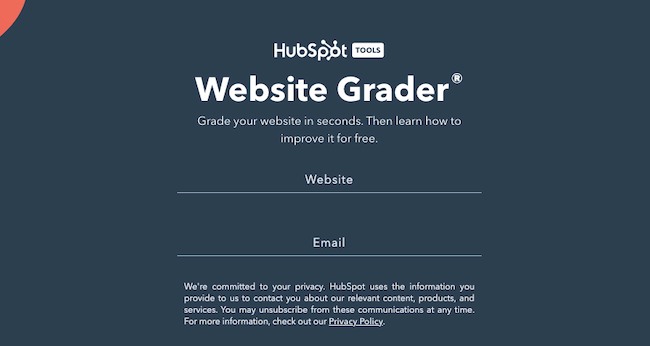





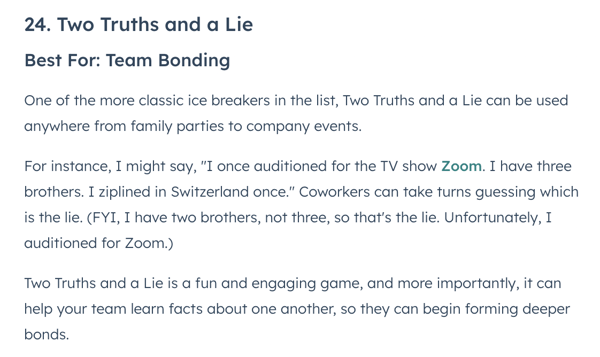


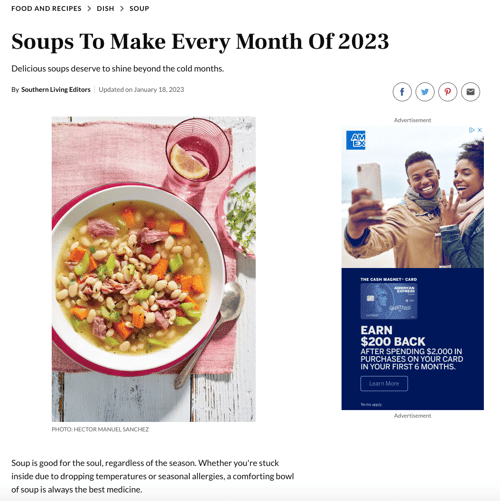
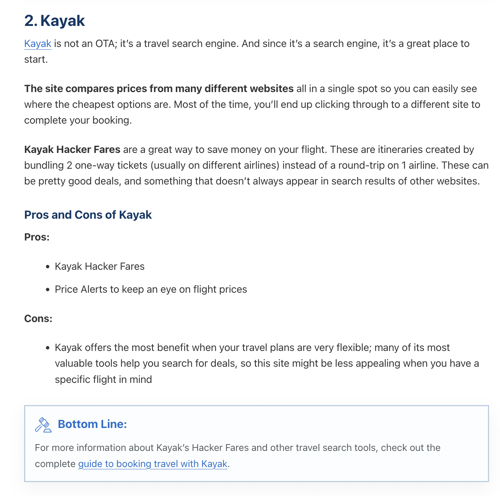



![Download Now: The 2023 State of Social Media Trends [Free Report]](https://i4lead.com/wp-content/uploads/2023/03/3dc1dfd9-2cb4-4498-8c57-19dbb5671820-2.png)

![Free Guide: How to Use AI in Content Marketing [Download Now]](https://i4lead.com/wp-content/uploads/2023/03/3e25e192-30c3-40c1-a7da-a4d054c9e157-4.png)
